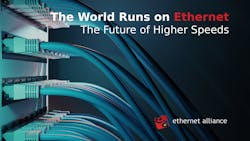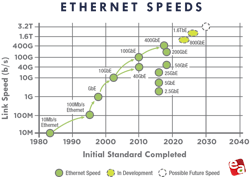By David J. Rodgers / Ethernet Alliance
In 2023, Ethernet celebrated its Golden Anniversary. One of the reasons this technology has lasted for half a century now is its unstoppable march toward ever-higher speeds. It spans a dynamic range of rates from 10 Mbps to 1.6 Tbps. The appetite for higher speed continues to propel Ethernet innovation and standards work.
So, what does the future of Ethernet look like? Fast. Very fast.
Arguably, the rapid acceptance and adoption of 800 Gbps and 1.6 Tbps Ethernet rates parallel mounting demand for increasingly powerful Artificial Intelligence (AI), High-Performance Computing (HPC), and Machine Learning (ML) applications. But the true champion is the average consumer.
We live in an age where most of us own a smartphone, streaming device, or some other IoT device that connects to the internet through wired and wireless connections. With the debut of the first iPhone in 2007, the average internet speed hovered below 20 Mb/s, and consumer residential access download speeds were miserly at ~3.5 Mbps. Fast-forward to today, and average US consumer download speeds are 30x faster, clocking in at ~100 Mbps. User demands – nay, expectations – their access to information and entertainment is instantaneous, coupled with an exponential rise in connected appliances, making the need for speed self-evident.
Turbocharged networking innovations
The question of how innovation is catalyzing the Ethernet industry to achieve a blistering 200 Gbps/lane speed is a multifaceted one. Indeed, advances in silicon and hardware development provide how newer, faster, and more efficient product designs can be realized. The ecosystem requires platforms capable of achieving these speeds internally, as well as interconnect solutions that are equally capable of carrying high-speed traffic across the data center, campus, municipality, and the world at large. Not surprisingly, then, it is the interconnect sector that is experiencing the most significant upheaval in pursuit of that 200 Gbps/lane goal.
With the combination of PAM4 modulation, signaling speeds, and the increased distances between connections contributing to an alphabet soup of new interfaces, it is becoming more evident moving forward that the solution for reliable interconnections is optical. For example, emerging coherent signaling has emerged among the most significant advancements we’ve seen thus far. Capable of supporting transmission of 400 Gb/s connections with a reach upwards of 120km, when coupled with dense wavelength-division multiplexing (DWM and DWDM). technologies enabling eight concurrent traffic streams, a single fiber connection can support 3.2 Tbps.
Accelerating standardization
There are several paths by which Ethernet applications, interconnects, and speeds are brought to market. Ethernet, by its very nature, is inherently adaptable, malleable, and resilient. As such, it is easily deployable across many vertical applications and media types and is supported by an expansive array of products and suppliers.
However, the only way Ethernet ecosystem stakeholders can deliver interoperable products is by adopting and adhering to relevant standards. Recognized as the de facto standards body for Ethernet, the process by which IEEE facilitates new Ethernet adaptations is both well-defined and proven to be highly effective. Already, the IEEE 802.3df Ethernet Task Force is blazing a trail to higher speeds through proposed standards addressing 800 Gbps and 1.6 Tbps Ethernet.
Beyond IEEE, there are other means by which Ethernet technology evolves, most notably through Multi-Source Agreements (MSA). Loosely defined, MSAs or consortia groups typically include critical players within the Ethernet ecosystem coming together and focusing their collective efforts on addressing a specific market segment or application. For example, the Ultra-Ethernet Consortium was recently launched with a mission to optimize Ethernet for use in burgeoning artificial intelligence and machine learning applications.
Evolving test and measurement
Test and measurement cannot escape the profound – and swift! – evolution gripping Ethernet, networking technologies, and how we approach 24/7 connectivity. It, too, is metamorphosing at a rapid pace to address better new requirements dictated by today’s cutting-edge high-speed products.
Conventional methods and tools have given way to novel platforms intelligently integrating signal integrity and logic testing, producing a new generation of hybrid devices. The tight integration of hardware and software in today’s Ethernet also requires a creative reimagining of test practices to accommodate these emerging toolsets. The once sharply defined distinction between hardware and software has now softened thanks to the intricacies of the growing transport speeds and optimized application and protocol communications requirements. Hardware and software validation teams work in unison these days, sometimes even at the same bench, when debugging new designs as interdependencies are detected.
With higher speeds and more advanced protocols, the critical impact of test and measurement tools must be accounted for. Often, this means designing for the test by embedding probe points at crucial locations, de-embedding the effects of the test fixtures and tools on the device(s) under test and mitigating spurious anomalies in the test bench.
Driving interoperability
The Ethernet Alliance has a compelling and long-standing history of supporting the challenge of assuring interoperability with the expanding catalog of Ethernet specifications. Our semi-annual interoperability “plugfests” provide a neutral and secure setting wherein engineering assets from various product and solutions vendors may interact in confidence to prove out new designs. As speeds and applications abound, these plugfest events have become more critical. Not only must these pre-market products be able to work together, but they also need to do so within the framework of legacy installations and deployments in today’s data centers.
The Ethernet Alliance supports these plugfests across the many variants of Ethernet, including but not limited to Single Pair Ethernet (SPE), Power over Ethernet (PoE), industrial Ethernet, and premise, as well as the latest high-speed platforms and applications.
Publicly, the Ethernet Alliance demonstrates interoperability in various forums, most notably at the annual Optical Fibre Communication Conference and Exhibition (OFC) and the European Conference on Optical Communication (ECOC) trade shows. As one of the centerpieces of these events, our multi-vendor interoperability demos bring together the latest in customer-ready products and tools representing real-world Ethernet solutions, proving the viability of the specification in support of today’s applications.
Navigating a changing landscape
With the breakneck pace of changes to Ethernet and its supporting ecosystem, navigating this shifting environment can be challenging. Luckily, the Ethernet Alliance is here to help by regularly publishing the industry’s only comprehensive Ethernet Roadmap.
In addition to covering major application areas, the roadmap details Ethernet’s expanding range of speeds, interfaces, and form factors. This free, publicly available, and regularly updated roadmap is just one of the many resources produced by the Ethernet Alliance.
David J. Rodgers is a board member and the events and conferences committee chair for the Ethernet Alliance. He currently represents EXFO for High-Speed electro-optical Test Technologies, including Ethernet and Fibre Channel, in various protocol industry groups.

